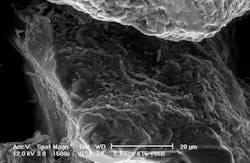In the last five years, the environmental problem known as PFAS has become mainstream public knowledge and a growing public concern. Aided by popular movies, books, and environmental advocates, including dozens of recently-formed citizen action groups, many have now heard of PFAS — shorthand for per- and polyfluoroalkyl substances — and are familiar with one or more potential health consequences from prolonged exposure to these chemicals — e.g., cancer, immune system malfunctions, hypertension, thyroid and kidney disease.
When introduced to the marketplace in the early 1950’s due to features like oil and water repellency, flame retardancy, and general indestructibility, PFAS have been used in industrial and product manufacturing for at least eight decades. Their seemingly ubiquitous usage in a wide range of consumer products and frequent daily contact with these "forever chemicals" is assured for most people. For instance, PFAS is found in:
- Carpets and upholstery (including child car seats!);
- Cosmetic and personal hygiene products such as dental floss and makeup;
- Food wrappers and carry-out containers;
- Water resistant shoes and clothing; and
- Cookware.
While exposure to PFAS in these everyday items is becoming increasingly well known, new information continues to surface pointing to some of the more surprising places PFAS can be found, from the far away to the very local.
RELATED: PFAS 101: "Forever Chemicals" in Drinking Water
PFAS in the Remote Arctic
A recent study assessed 29 PFAS coming into and out of the Arctic Ocean. The study identified the widespread distribution of 11 PFAS, including PFOA, which has mostly been phased out of the industry, and a newer replacement PFAS: HFPO-Dimer Acid (sold under the trade name Gen-X). Higher levels of PFAS were detected in the water exiting the Arctic Ocean compared with the water entering the Arctic from the North Atlantic, suggesting that more of these compounds arose from atmospheric sources than from ocean circulation.1 PFAS has also been shown to bioaccumulate in the Arctic marine ecosystem, including in seals, waterfowl and even the brain tissue of polar bears.2
PFAS in Fracking Chemicals
Many are not looking for another reason to disfavor the practice of using hydraulic fracturing (i.e., fracking) to extract oil and gas from the ground. And by now, many more communities are becoming less enamored with the thought that PFAS has been so widely used in so many products and processes for so long. But the idea of using PFAS chemicals for fracking represents a severe double negative. And yet, a recent report, Fracking with "Forever Chemicals," published by the Physicians for Social Responsibility, suggests that the practice of using certain PFAS in the fracking chemical mixture has been going on for the past decade. Despite environmental concerns posited by the EPA, the use of "trade-secret non-ionic fluorosurfactants" was approved by the agency and has been applied at more than 1,200 wells in six states.3
PFAS in The Vegetable Drawer?
Dietary intake is a major potential exposure pathway for PFAS that continues to be assessed. A 2018 study by the U.S. Food and Drug Administration (FDA) sampled foods, including lettuce, cabbage, corn and tomatoes, from areas of the country with known PFAS contamination. Of the 20 samples, 16 were found to contain PFAS.4 Produce using irrigation water or soil contaminated with PFAS readily uptake the chemicals, with contaminant transfer influenced by concentrations and mixtures of PFAS, plant species, soil organic carbon and other factors.5 Thus, dietary exposure to PFAS is very likely when contaminated irrigation water is used, pointing to the need for further studies, testing and eventually the establishment of PFAS limits for irrigation water.
PFAS in Blood
According to the U.S. Center for Disease Control (CDC) data, PFAS is found in almost all Americans' blood, regardless of age, race, or gender. And although the CDC states, "Human health effects from PFCs at low environmental doses or at bio-monitored levels from low environmental exposures are unknown," the fact that the average total PFAS in blood serum currently exceeds 5,000 parts per trillion (ppt) should make one pause.6 Trends over time indicate these levels are slowly decreasing as PFAS materials are gradually phased out of manufacturing. Nevertheless, there is much work to be done to identify and remove the PFAS sources contributing to all the various source of PFAS in our blood. One of the most potentially significant of these PFAS sources, we have been advised to consume regularly.
PFAS in Drinking Water
After nearly 80 years of manufacturing, uncontrolled releases, and disposal practices, it should not be too surprising that PFAS is found in drinking water. It is, however, the vast extent of these impacts that is both surprising and unsettling. According to recent estimates by the Environmental Working Group, more than 200 million Americans may be exposed to PFAS simply by drinking a glass of water. And to date, more than 2,200 public water supplies have been identified with PFAS contaminants.7 From the lens of human health and risk assessment, much of the nation's drinking water is now considered a source of PFAS exposure.
Groundwater supplies approximately 40% of U.S. drinking water.8 The risk of PFAS groundwater contamination is most significant where it is encountered at shallow depths and where there are PFAS sources nearby (e.g. a fire training area at a military base). It is impossible to know, as we are only beginning to comprehend, how many PFAS-contaminated groundwater sites exist, but there are undoubtedly many thousands. Fortunately, a field-proven method is available and being used now to effectively address PFAS contamination in groundwater near these source areas and cut off these contaminants from potential human and environmental exposure.
RELATED: What to Expect for PFAS
Colloidal Activated Carbon Barriers for PFAS Removal
This PFAS treatment approach uses a colloidal form of activated carbon applied in situ – i.e. directly into the groundwater. The colloidal activated carbon (CAC) treatment works by intercepting contaminants that move naturally through established groundwater pathways. To accomplish this, CAC is injected along a line of delivery points into the affected aquifer zone to form a permeable reactive barrier (PRB). As groundwater migrates across the PRB, PFAS sorbs onto the carbon, removing it from the water. With PFAS removed from the water, the exposure pathway is eliminated and so is the risk.
Material scientists developed CAC to overcome the challenge of evenly dispersing a solid injected material (i.e., activated carbon) through aquifer soils. Activated carbon particles are ground to 1 to 2 microns — the size of a red blood cell — and treated with a proprietary and drinking water-safe, anti-clumping agent that allows the CAC to permeate through and then adhere to the surface of individual soil grains.
In situ CAC treatments have been used to capture and treat groundwater contaminants since 2014 and applied at numerous PFAS-contaminated groundwater sites. Over one hundred PFAS projects have been implemented or are in the planning stages. The longest-running application has reduced PFAS for five years, with the treatment expected to be maintained 50 years based on independent, peer-reviewed modeling estimates.9 The approach is substantially more cost effective and technically feasible compared to any other treatment alternative. Performance-based warranty options are available from the manufacturer that can be tailored to a project’s needs.
PFAS Article References
1. Newer PFAS compound detected for first time in Arctic seawater. American Chemical Society. Accessed July 15, 2021. https://www.acs.org/content/acs/en/pressroom/presspacs/2020/acs-presspac-july-29-2020/newer-pfas-compound-detected-for-first-time-in-arctic-seawater.html
2. Greaves AK, Letcher RJ, Sonne C, Dietz R. Brain region distribution and patterns of bioaccumulative perfluoroalkyl carboxylates and sulfonates in East Greenland polar bears (Ursus maritimus). Environmental Toxicology and Chemistry. 2013;32(3):713-722. doi:https://doi.org/10.1002/etc.2107
3. Horwitt D. Fracking with “Forever Chemicals.” :34.
4. Nutrition C for FS and A. Analytical Results of Testing Food for PFAS from Environmental Contamination. FDA. Published online June 30, 2021. Accessed July 16, 2021. https://www.fda.gov/food/chemical-contaminants-food/analytical-results-testing-food-pfas-environmental-contamination
5. Brown JB, Conder JM, Arblaster JA, Higgins CP. Assessing Human Health Risks from Per- and Polyfluoroalkyl Substance (PFAS)-Impacted Vegetable Consumption: A Tiered Modeling Approach. Environ Sci Technol. 2020;54(23):15202-15214. doi:10.1021/acs.est.0c03411
6. Biomonitoring Summary | CDC. Published May 24, 2019. Accessed July 15, 2021. https://www.cdc.gov/biomonitoring/PFAS_BiomonitoringSummary.html
7. Andrews DQ, Naidenko OV. Population-Wide Exposure to Per- and Polyfluoroalkyl Substances from Drinking Water in the United States. Environ Sci Technol Lett. 2020;7(12):931-936. doi:10.1021/acs.estlett.0c00713
8. Groundwater Use in the United States. Accessed July 16, 2021. https://www.usgs.gov/special-topic/water-science-school/science/groundwater-use-united-states?qt-science_center_objects=0#qt-science_center_objects
9. Carey GR, McGregor R, Pham AL-T, Sleep B, Hakimabadi SG. Evaluating the longevity of a PFAS in situ colloidal activated carbon remedy. Remediation Journal. 2019;29(2):17-31. doi:https://doi.org/10.1002/rem.21593
About the Author
Ryan Moore
Ryan Moore, CHMM, is a REGENESIS PFAS program manager, focused on collaborating with environmental professionals and the industry to communicate effective, proven approaches to manage sites where PFAS contaminants exceed regulatory standards. Moore has managed the use of PlumeStop, Colloidal Activated Carbon, available exclusively through REGENESIS, to treat PFAS and other organic pollutants since its inception in 2014. Contact him at [email protected] or 219.286.4838.


